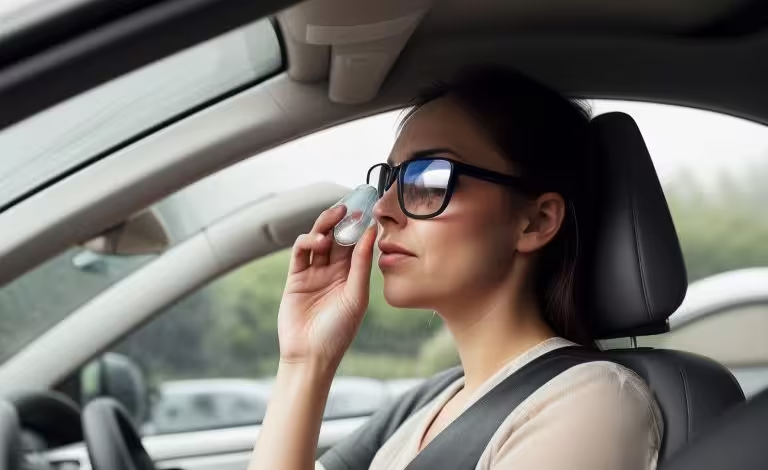How Can Dry Eyes Impact Your Driving Ability? 🚗👀

How Can Dry Eyes Impact Your Driving Ability? 🚗👀
Driving is all about focus, reaction time, and being alert to everything around you. But what if dry eyes make it harder to keep your eyes on the road? This issue, often overlooked, can significantly impact your driving ability. Let’s dive into how dry eyes affect driving and what you can do to stay safe behind the wheel.
What Are Dry Eyes? 🌵
Dry eyes occur when your eyes can’t produce enough tears or the right quality of tears to keep your eyes lubricated. This can lead to discomfort, blurred vision, and even damage to the eye’s surface. It’s like trying to drive with a foggy windshield—everything gets a bit more challenging.
Common Symptoms of Dry Eyes:
- Stinging or burning sensation
- Redness in the eyes
- Sensitivity to light
- Feeling like there’s something in your eye
- Watery eyes (as a response to irritation)
- Blurred vision
Why Are Dry Eyes a Problem for Drivers? 🚗🔴
Driving requires sharp, clear vision. Any issue that compromises this can make driving dangerous, not just for you but for everyone on the road. Here’s how dry eyes can impact your driving:
1. Blurred Vision 🛣️
When your eyes are dry, your vision can blur unexpectedly. This can make it difficult to read road signs, judge distances, or even see pedestrians. Imagine missing a stop sign because your vision suddenly went blurry—scary, right?
2. Eye Fatigue 😴
Dry eyes often cause your eyes to tire more quickly. Long drives can become exhausting, and you might find yourself needing to take frequent breaks to rest your eyes. Fatigued eyes can slow your reaction times, which is crucial in avoiding accidents.
3. Discomfort and Distraction 🚨
Dry eyes can be downright painful. The constant need to blink or rub your eyes can take your focus away from the road. Even a momentary lapse in attention can lead to dangerous situations.
4. Increased Sensitivity to Light 🌞
Bright lights, whether from the sun or oncoming headlights at night, can be particularly harsh on dry eyes. This increased sensitivity can make it hard to see clearly and cause more discomfort.
Tips for Driving with Dry Eyes 📝
Now that we know how dry eyes can impact driving, let’s look at some tips to help you manage this condition and stay safe on the road.
1. Use Artificial Tears 💧
Keeping a bottle of artificial tears in your car can provide quick relief. Use them before you start your journey and during breaks to keep your eyes lubricated.
2. Wear Sunglasses 🕶️
Sunglasses can protect your eyes from harsh sunlight and reduce glare, making it easier for you to see and drive comfortably. Polarized lenses are particularly effective.
3. Take Regular Breaks ⏱️
On long drives, make it a habit to stop every hour or so. This gives your eyes a chance to rest and rehydrate, reducing fatigue.
4. Stay Hydrated 🚰
Drinking plenty of water helps keep your body, including your eyes, hydrated. Dehydration can worsen dry eyes, so always have a bottle of water handy.
5. Adjust Your Car’s Environment 🚗🌡️
Use the air conditioner sparingly and avoid directing vents straight at your face, as this can dry out your eyes faster. Keeping the humidity up in your car can also help.
6. Consult an Eye Specialist 👩⚕️👨⚕️
If you frequently experience dry eyes, it’s worth seeing an eye specialist. They can provide treatments tailored to your needs, such as prescription eye drops or other therapies.
When to Avoid Driving 🚫
There are times when it might be best to avoid driving altogether if your dry eyes are particularly bad. If you experience severe discomfort, extreme sensitivity to light, or frequent bouts of blurred vision, consider alternative transportation options until you can manage your symptoms better.
Dry eyes might seem like a minor inconvenience, but they can have a major impact on your driving ability. From blurred vision to increased sensitivity to light, the symptoms can make driving both difficult and dangerous. By taking steps to manage your dry eyes, such as using artificial tears, wearing sunglasses, and staying hydrated, you can improve your comfort and safety on the road. Always remember, your safety and the safety of others come first—never hesitate to seek help if you need it. Safe driving! 🚗👀
